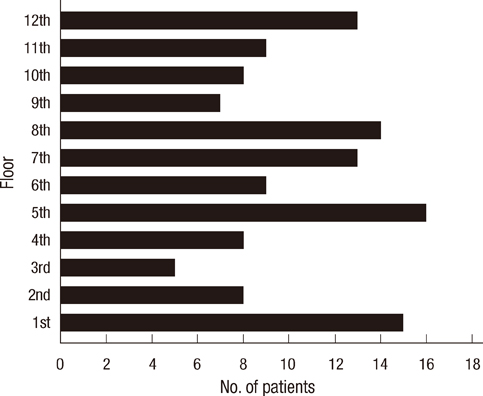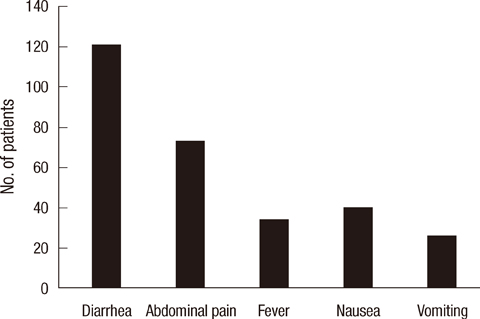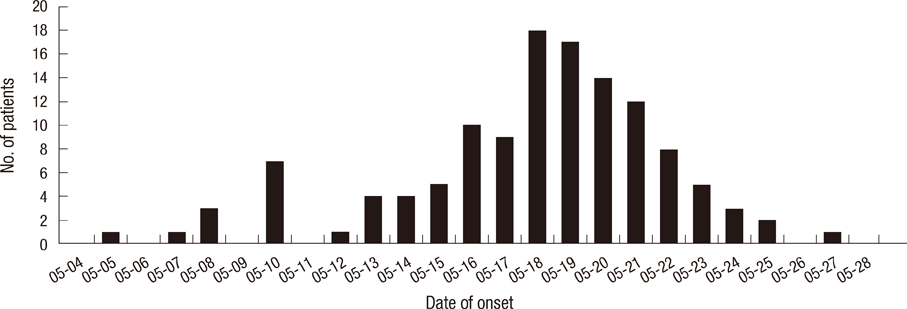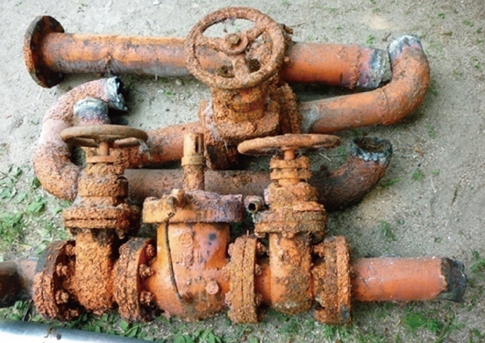J Korean Med Sci.
2013 Jul;28(7):983-989. 10.3346/jkms.2013.28.7.983.
Epidemiological Characteristics of the First Water-Borne Outbreak of Cryptosporidiosis in Seoul, Korea
- Affiliations
-
- 1Division of Epidemic Intelligence Service, Korea Centers for Disease Control and Prevention, Cheongwon, Korea. yunki7777@naver.com
- 2Division of Health Policy, Seoul Metropolitan Government, Seoul, Korea.
- 3Healthcare Department of Dongdaemun-gu Public Health Center, Seoul, Korea.
- KMID: 1777492
- DOI: http://doi.org/10.3346/jkms.2013.28.7.983
Abstract
- The first case of human cryptosporidiosis was reported in Korea in 1995; however, an outbreak of Cryptosporidium has not been reported in Korea until now. This paper describes the first outbreak of cryptosporidiosis in Korea. On May 24, 2012, a local public health center filed a report on 126 residents with gastrointestinal symptoms in an old apartment complex in Seoul. Epidemiological investigations were implemented on 125 of the 126 patients. The patients were reported continuously over a period of 22 days. Diarrhea was the most common clinical symptom, and lasted for 5 days on average. The tap water was the only common exposure of the patients. During the environmental investigation it was discovered that the water and septic tanks were situated closely and that the waste water pipes were corroded where they passed over the water pipes. Cryptosporidium parvum was detected in 3 of the 7 stool specimens by PCR-RFLP. A number of Cryptosporidium oocysts were also detected in the water specimens from the water tank. In conclusion, Cryptosporidium parvum was the key causal pathogen of this outbreak. It is presumed that the tap water was contaminated by a sewage leak from the aged pipelines.
Keyword
MeSH Terms
-
Adolescent
Adult
Aged
Aged, 80 and over
Child
Child, Preschool
Cryptosporidiosis/*epidemiology/parasitology
Cryptosporidium parvum/*isolation & purification
Diarrhea/parasitology
*Disease Outbreaks
Drinking Water/*parasitology
Female
Food Contamination
Humans
Infant
Infant, Newborn
Male
Middle Aged
Public Health
Republic of Korea/epidemiology
Sewage/parasitology
Young Adult
Drinking Water
Sewage
Figure
Cited by 1 articles
-
Status of common parasitic diseases in Korea in 2019
Sun Huh
J Korean Med Assoc. 2019;62(8):437-456. doi: 10.5124/jkma.2019.62.8.437.
Reference
-
1. Chalmers RM, Davies AP. Minireview: clinical cryptosporidiosis. Exp Parasitol. 2010. 124:138–146.2. Cama VA, Bern C, Roberts J, Cabrera L, Sterling CR, Ortega Y, Gilman RH, Xiao L. Cryptosporidium species and subtypes and clinical manifestations in children, Peru. Emerg Infect Dis. 2008. 14:1567–1574.3. Yoder JS, Harral C, Beach MJ. Centers for Disease Control and Prevention (CDC). Cryptosporidiosis surveillance - United States, 2006-2008. MMWR Surveill Summ. 2010. 59:1–14.4. Takagi M, Toriumi H, Endo T, Yamamoto N, Kuroki T. An outbreak of cryptosporidiosis associated with swimming pools. Kansenshogaku Zasshi. 2008. 82:14–19.5. Baldursson S, Karanis P. Waterborne transmission of protozoan parasites: review of worldwide outbreaks - an update 2004-2010. Water Res. 2011. 45:6603–6614.6. Kang YK, Lee HK, Kim SW, Chi JG. Cryptosporidiosis in a leukemia child with severe diarrhea. Seoul J Med. 1995. 36:29–34.7. Seo M, Huh S, Chai JY, Yu JR. An epidemiological survey on Cryptosporidium parvum infection of inhabitants in Chorwon-gun, Kangwon-do. Korean J Parasitol. 2001. 39:201–203.8. Chai JY, Lee SH, Guk SM, Lee SH. An epidemiological survey of Cryptosporidium parvum infection in randomly selected inhabitants of Seoul and Chollanam-do. Korean J Parasitol. 1996. 34:113–119.9. Yu JR, Lee JK, Seo M, Kim SI, Sohn WM, Huh S, Choi HY, Kim TS. Prevalence of cryptosporidiosis among the villagers and domestic animals in several rural areas of Korea. Korean J Parasitol. 2004. 42:1–6.10. Park JH, Guk SM, Han ET, Shin EH, Kim JL, Chil JY. Genotype analysis of Cryptosporidium spp. prevalent in a rural village in Hwasun-gun, Republic of Korea. Korean J Parasitol. 2006. 44:27–33.11. Park JH, Kim HJ, Guk SM, Shin EH, Kim JL, Rim HJ, Lee SH, Chai JY. A survey of cryptosporidiosis among 2,541 residents of 25 coastal islands in Jeollanam-do (Province), Republic of Korea. Korean J Parasitol. 2006. 44:367–372.12. Korea Centers for Disease Control and Prevention. Epidemiologic investigation guideline for food and waterborne diseases 2012. 2012. Cheongwon: Division of Epidemic Intelligence Service, Korea Centers for Disease Control and Prevention.13. Lee SH, Joung M, Yoon S, Choi K, Park WY, Yu JR. Multiplex PCR detection of waterborne intestinal protozoa; Microsporidia, Cyclospora and Cryptosporidium. Korean J Parasitol. 2010. 48:297–301.14. Ramirez NE, Ward LA, Sreevatsan S. A review of the biology and epidemiology of cryptosporidiosis in humans and animals. Microbes Infect. 2004. 6:773–785.15. Garcia LS, Bruckner DA, Brewer TC, Shimizu RY. Techniques for the recovery and identification of Cryptosporidium oocysts from stool specimens. J Clin Microbiol. 1983. 18:185–190.16. Nielsen CK, Ward LA. Enhanced detection of Cryptosporidium parvum in the acid-fast stain. J Vet Diagn Invest. 1999. 11:567–569.17. Chan R, Chen J, York MK, Setijono N, Kaplan RL, Graham F, Tanowitz HB. Evaluation of a combination rapid immunoassay for detection of Giardia and Cryptosporidium antigens. J Clin Microbiol. 2000. 38:393–394.18. Sulaiman IM, Xiao L, Lal AA. Evaluation of Cryptosporidium pavum genotyping techniques. Appl Environ Microbiol. 1999. 65:4431–4435.19. Sharp SE, Suarez CA, Duran Y, Poppiti RJ. Evaluation of the Triage Micro Parasite Panel for detection of Giardia lamblia, Entamoeba histolytica/Entamoeba dispar, and Cryptosporidium parvum in patient stool specimens. J Clin Microbiol. 2001. 39:332–334.20. Elwin K, Chalmers RM, Roberts R, Guy EC, Casemore DP. Modification of a rapid method for the identification of gene-specific polymorphisms in Cryptosporidium parvum and its application to clinical and epidemiological investigations. Appl Environ Microbiol. 2001. 67:5581–5584.21. Korea Centers for Disease Control and Prevention. Epidemiologic investigation guideline for food and waterborne diseases 2013 revised ed. 2013. Cheongwon: Division of Epidemic Intelligence Service, Korea Centers for Disease Control and Prevention.22. Lynch M, Painter J, Woodruff R, Braden C. Centers for Disease Control and Prevention. Surveillance for foodborne-disease outbreaks: United States, 1998-2002. MMWR Surveill Summ. 2006. 55:1–42.23. Huang DB, White AC. An updated review on Cryptosporidium and Giardia. Gastroenterol Clin North Am. 2006. 35:291–314.24. Mac Kenzie WR, Hoxie NJ, Proctor ME, Gradus MS, Blair KA, Peterson DE, Kazmierczak JJ, Addiss DG, Fox KR, Rose JB, et al. A massive outbreak in Milwaukee of cryptosporidium infection transmitted through the public water supply. N Engl J Med. 1994. 331:161–167.25. MacKenzie WR, Schell WL, Blair KA, Addiss DG, Peterson DE, Hoxie NJ, Kazmierczak JJ, Davis JP. Massive outbreak of waterborne cryptosporidium infection in Milwaukee, Wisconsin: recurrence of illness and risk of secondary transmission. Clin Infect Dis. 1995. 21:57–62.26. Newman RD, Sears CL, Moore SR, Nataro JP, Wuhib T, Agnew DA, Guerrant RL, Lima AA. Longitudinal study of Cryptosporidium infection in children in northeastern Brazil. J infect Dis. 1999. 180:167–175.27. DuPont HL, Chappell CL, Sterling CR, Okhuysen PC, Rose JB, Jakubowski W. The infectivity of Cryptosporidium parvum in healthy volunteers. N Engl J Med. 1995. 332:855–859.28. Lee MY, Cho EJ, Lee JH, Han SH, Park YS. A survey of Cryptosporidium oocysts in water supplies during a 10-year period (2000-2009) in Seoul. Korean J Parasitol. 2010. 48:219–224.
- Full Text Links
- Actions
-
Cited
- CITED
-
- Close
- Share
- Similar articles
-
- Cryptosporidiosis
- The First Outbreak of Giardiasis with Drinking Water in Korea
- A Waterborne Outbreak and Detection of Cryptosporidium Oocysts in Drinking Water of an Older High-Rise Apartment Complex in Seoul
- Epidemiological investigation on the outbreak of foodborne and waterborne disease due to Norovirus with delayed notification
- Trends of Recent Food-Borne Disease Outbreaks in Korea






